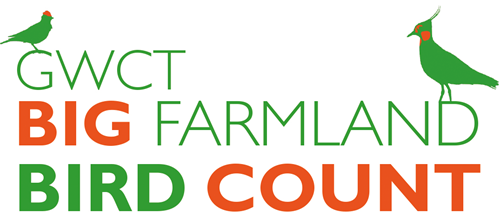The UK’s farmers, gamekeepers and land managers are being urged to get involved in the GWCT Big Farmland Bird Count from 4-20 February 2022, and make a crucial difference to wildlife.

“2021’s GWCT Big Farmland Bird Count was record-breaking, and we want to thank all those who took part. Now we are challenging the UK’s land managers to beat their own record and make 2022’s count bigger than ever,” said Dr Roger Draycott, organiser and head of advisory services at the GWCT.
“The latest assessment of the status of the UK’s birds, the Birds of Conservation Concern (BoCC) list, published this month, sadly shows that more than one in four species is in serious trouble. Land managers and gamekeepers can make a real and immediate difference by adopting effective conservation measures. The UK’s farmland birds are counting on you!”
The Big Farmland Bird Count is organised by the Game & Wildlife Conservation Trust (GWCT) to encourage land managers to support farmland birds and to highlight the hard work already done by many farmers and gamekeepers to help reverse species’ declines. The count also gives a vital national snapshot of the health of the UK’s birdlife.
2021 saw the number of counts submitted leap from 1,500 to 2,500, with participants counting across a massive 2.5 million acres of England, Scotland, Wales and Northern Ireland, up from 1.4 million acres in 2020. Organisers hope that even more people will get involved this year.
“71% of the UK’s countryside is looked after by farmers and land managers, many of whom care deeply for the wildlife on their land, so they are in a position to make a real difference,” continued Roger. “A few small changes, such as providing supplementary winter feeding or growing crops specifically to provide seed for birds, can have a significant impact.
“Carrying out a count on your land takes just 30 minutes and gives you a chance to measure the impacts of your conservation efforts and get GWCT-science-based advice on boosting biodiversity. And your results help give GWCT scientists a crucial insight into which bird species are thriving and which are struggling.”
For the fourth year running the 2022 count, which will be the ninth, is sponsored by the National Farmers’ Union (NFU), demonstrating the farming community’s commitment to conserving our native bird species. NFU president Minette Batters said: “This year’s results were fantastic, with farmers and growers across the country responding to the count in record numbers spotting many different threatened species such as lapwing and linnet.
“Not only are farmers producing climate-friendly food, they are also maintaining and protecting the great British countryside, creating habitats for wildlife and additional feeding for farmland birds.
“I encourage all farmers to get involved in the 2022 GWCT Big Farmland Bird Count as it is such a great way to monitor and record the birdlife found on farm.”
The GWCT Big Farmland Bird Count is also supported by farming bodies in Wales, Scotland and Northern Ireland*.
Tim Walters from Hampshire, who takes part in the count annually, said: “I really enjoy doing the Big Farmland Bird Count each year. As we continue to be heavily involved in stewardship and environmental work on the farms, it is really interesting to spend half an hour each year counting wild birds. It is a good break from the rigours of day-to-day commercial farming and shows the beneficial work that so many farming colleagues do to manage the countryside and its flora and fauna.”
Encouragingly, a total of 25 species from the Red List for Birds of Conservation Concern were recorded in the 2021 GWCT Big Farmland Bird Count, with eight appearing in the 25 most frequently seen species list. Of these, starlings, fieldfare, lapwing and linnet were the four most abundant red-listed species recorded, with over 112,000 spotted in total, which equates to 22% of all the birds counted. The five most abundant birds counted were woodpigeons, starling, rooks, fieldfare and chaffinch. A total of 190,000 were seen, making up over 37% of the total number of birds recorded.
How to take part in the Big Farmland Bird Count
Species guides, including short videos, are available at www.bfbc.org.uk.
- Download your count sheet from the BFBC website.
- Count your birds! On a day between 4 and 20 February, spend about 30 minutes recording the species and number of birds seen on one particular area of the farm.
- Once you've completed your count, simply submit your results online at www.bfbc.org.uk.
Note to editors
The GWCT Big Farmland Bird Count is sponsored by the National Farmers’ Union (NFU).
*It is also kindly supported by:
- CLA
- FWAG: Farming and Wildlife Advisory Group
- NSA: National Sheep Association
- LEAF: Linking Environment and Farming
- Kings
- NFU Scotland
- NFU Cymru
- Perdix
- CFE: Championing the Farmed Environment
- Ulster Farmers’ Union
- FUW: Farmers’ Union of Wales
- Camgrain
Notes for editors:
The Game & Wildlife Conservation Trust – providing research-led conservation for a thriving countryside. The GWCT is an independent wildlife conservation charity which has carried out scientific research into Britain’s game and wildlife since the 1930s. We advise farmers and landowners on improving wildlife habitats. We employ 14 post-doctoral scientists and 50 other research staff with expertise in areas such as birds, insects, mammals, farming, fish and statistics. We undertake our own research as well as projects funded by contract and grant-aid from Government and private bodies.
* GWCT’s Big Farmland Bird Count is sponsored by the NFU and delivered in partnership with the Farmers Union of Wales, Ulster Farmers’ Union, NFU Cymru, NFU Scotland, Kings, CFE, FWAG, National Sheep Association, Camgrain, LEAF, the CLA and Perdix.
For information, contact:
Eleanor Williams
Telephone: 07592 025476